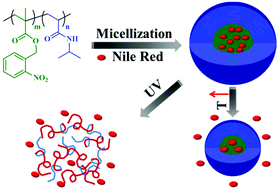Micellar assembly of a photo- and temperature-responsive amphiphilic block copolymer for controlled release†
Abstract
A novel dual-stimuli-sensitive amphiphilic block copolymer, poly(N-isopropylacrylamide)-block-poly(2-nitrobenzyl methacrylate) (PNIPAM-b-PNBM), was synthesized via two steps of reversible addition–fragmentation chain transfer polymerization (RAFT). In aqueous media, this well-defined block copolymer could self-assemble into micellar nanoparticles with a photo-sensitive PNBM segment as the hydrophobic core and a temperature-sensitive PNIPAM segment as the hydrophilic shell. The morphological structures of the self-assembled micellar nanoparticles, which could be photo-disrupted with light and shrunk at higher temperature, were characterized by transmission electron microscopy (TEM) and dynamic light scattering (DLS). The controlled release of encapsulated hydrophobic guest molecules from the polymeric nanoparticles could be achieved under stimulation with light or temperature change. More interestingly, the release could be enhanced efficiently under the combined stimulation in comparison to that under a single stimulation. The prepared photo- and temperature-responsive polymeric micellar nanoparticles may have great potential for applications in the areas of nanotechnology and biotechnology for controlled release.


 Please wait while we load your content...
Please wait while we load your content...